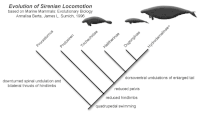Evolution of sirenians
This article has multiple issues. Please help improve it or discuss these issues on the talk page. (Learn how and when to remove these template messages)
|
Origins





Sirenians, along with
Tethytheria, combined with
Fossil history
The first appearance of sirenians in the fossil record was during the early Eocene, and by the late Eocene, sirenians had significantly diversified. Inhabitants of rivers, estuaries, and nearshore marine waters, they were able to spread rapidly. The most primitive sirenian known to date, Prorastomus, was found in Jamaica, not the Old World; however more recently the contemporary Sobrarbesiren has been recovered from Spain.[2] The first known quadrupedal sirenian was Pezosiren from the early Eocene.[3] The earliest known sea cows, of the families Prorastomidae and Protosirenidae, are both confined to the Eocene, and were about the size of a pig, four-legged amphibious creatures. By the time the Eocene drew to a close, came the appearance of the Dugongidae; sirenians had acquired their familiar fully aquatic streamlined body with flipper-like front legs with no hind limbs, powerful tail with horizontal caudal fin, with up and down movements which move them through the water, like cetaceans.
In Western Europe the first and oldest sirenian remains have been found in a new paleontological site, in Santa Brígida, Amer (La Selva, Catalonia, Spain[4]). The age is dated by the Shallow Bentic Zones in the Eoceno SBZ 15).
The last of the sirenian families to appear, Trichechidae, are thought to have originated from early dugongids in the late Eocene or early Oligocene. The current fossil record documents some major stages in hindlimb and pelvic reduction (well developed hindlimbs attached to a sacrum (Prorastomidae), well developed hindlimbs without proper sacrum (Protosirenidae) and reduced innominate with hindlimbs reduced or absent (Dugongidae and Trichechidae).[5]
Since sirenians first evolved, they have been herbivores, likely depending on
Eocene sirenians, like Mesozoic mammals but in contrast to other Cenozoic ones, have five instead of four premolars, giving them a 3.1.5.3 dental formula. Whether this condition is truly a primitive retention in sirenians is still under debate.
Although cheek teeth are relied on for identifying species in other mammals, they do not vary to a significant degree among sirenians in their morphology, but are almost always low-crowned (
See also
References
- ISBN 9780520270572.
- PMID 29572454.
- S2CID 22005691.
- ^ Fuentes-Buxó, R., Fuentes-Buxó, A. 2016. Finding of sirenian remains in the Lutetian (Middle Eocene) of Santa Brígida (Amer, La Selva, Girona). Treballs del Museu de Geologia de Barcelona, 22: 19-24 .
- S2CID 86603486.
Further reading
- Domning DP (2002). "Sirenian Evolution". In Perrin WF, Würsig B, Thewissen JG (eds.). Encyclopedia of Marine Mammals. San Diego: Academic Press. pp. 1083–1086. ISBN 978-0125513401.
- Berta A (2012). "5. Diversity, Evolution, and Adaptation of Sirenians and Other Marine Mammals". Return to the Sea: The Life and Evolutionary Times of Marine Mammals. Berkeley: University of California Press. pp. 127–149. ISBN 978-0-520-27057-2.
- Berta A, Sumich JL, Kovacs KK (2006). "5. Sirenian and Other Marine Mammals: Evolution and Systematics". Marine Mammals: Evolutionary Biology (2nd ed.). Academic Press. pp. 89–110. ISBN 978-0-12-369499-7.
- Marsh H, O'Shea TJ, Reynolds JE III (2012). "3. Affinities, origins and diversity of the Sirenia through time". Ecology and Conservation of the Sirenia: Dugongs and Manatees. Conservation Biology. Vol. 18. Cambridge: Cambridge University Press. pp. 35–77. ISBN 978-0-521-71643-7.
- Velez-Juarbe J, Domning DP, PMID 22319622.
- Origin of Sirenians
- Macro-evolution at its finest Christina Reed, Geotimes December 2001
- Evolution of the Sirenia by Caryn Self-Sullivan at Sirenian International
